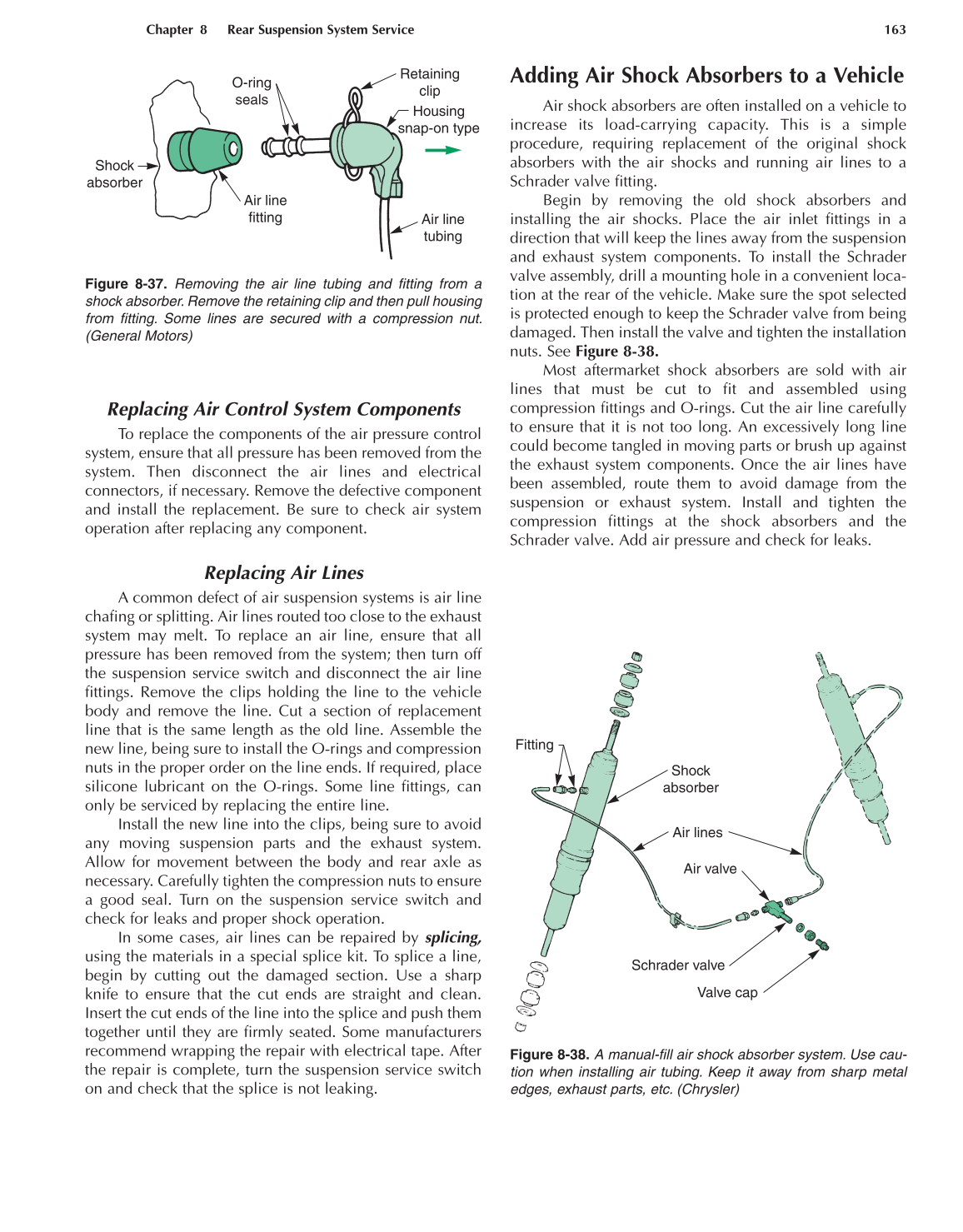Chapter 8 Rear Suspension System Service 163
Replacing Air Control System Components
To replace the components of the air pressure control
system, ensure that all pressure has been removed from the
system. Then disconnect the air lines and electrical
connectors, if necessary. Remove the defective component
and install the replacement. Be sure to check air system
operation after replacing any component.
Replacing Air Lines
A common defect of air suspension systems is air line
chafing or splitting. Air lines routed too close to the exhaust
system may melt. To replace an air line, ensure that all
pressure has been removed from the system; then turn off
the suspension service switch and disconnect the air line
fittings. Remove the clips holding the line to the vehicle
body and remove the line. Cut a section of replacement
line that is the same length as the old line. Assemble the
new line, being sure to install the O-rings and compression
nuts in the proper order on the line ends. If required, place
silicone lubricant on the O-rings. Some line fittings, can
only be serviced by replacing the entire line.
Install the new line into the clips, being sure to avoid
any moving suspension parts and the exhaust system.
Allow for movement between the body and rear axle as
necessary. Carefully tighten the compression nuts to ensure
a good seal. Turn on the suspension service switch and
check for leaks and proper shock operation.
In some cases, air lines can be repaired by splicing,
using the materials in a special splice kit. To splice a line,
begin by cutting out the damaged section. Use a sharp
knife to ensure that the cut ends are straight and clean.
Insert the cut ends of the line into the splice and push them
together until they are firmly seated. Some manufacturers
recommend wrapping the repair with electrical tape. After
the repair is complete, turn the suspension service switch
on and check that the splice is not leaking.
Adding Air Shock Absorbers to a Vehicle
Air shock absorbers are often installed on a vehicle to
increase its load-carrying capacity. This is a simple
procedure, requiring replacement of the original shock
absorbers with the air shocks and running air lines to a
Schrader valve fitting.
Begin by removing the old shock absorbers and
installing the air shocks. Place the air inlet fittings in a
direction that will keep the lines away from the suspension
and exhaust system components. To install the Schrader
valve assembly, drill a mounting hole in a convenient loca-
tion at the rear of the vehicle. Make sure the spot selected
is protected enough to keep the Schrader valve from being
damaged. Then install the valve and tighten the installation
nuts. See Figure 8-38.
Most aftermarket shock absorbers are sold with air
lines that must be cut to fit and assembled using
compression fittings and O-rings. Cut the air line carefully
to ensure that it is not too long. An excessively long line
could become tangled in moving parts or brush up against
the exhaust system components. Once the air lines have
been assembled, route them to avoid damage from the
suspension or exhaust system. Install and tighten the
compression fittings at the shock absorbers and the
Schrader valve. Add air pressure and check for leaks.
Retaining
clip
Housing
snap-on type
Air line
tubing
Air line
fitting
Shock
absorber
O-ring
seals
Figure 8-37. Removing the air line tubing and fitting from a
shock absorber. Remove the retaining clip and then pull housing
from fitting. Some lines are secured with a compression nut.
(General Motors)
Shock
absorber
Air lines
Air valve
Schrader valve
Valve cap
Fitting
Figure 8-38. A manual-fill air shock absorber system. Use cau-
tion when installing air tubing. Keep it away from sharp metal
edges, exhaust parts, etc. (Chrysler)
